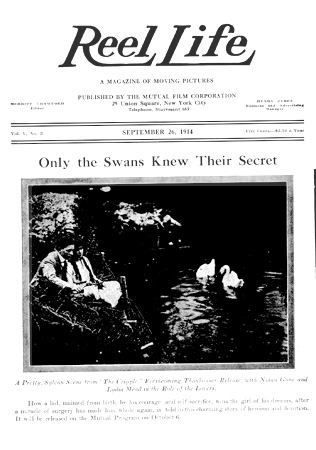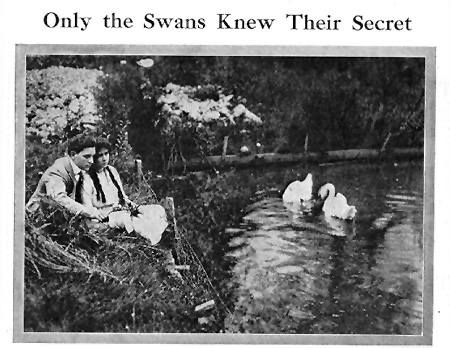 Volume II: Filmography
Volume II: Filmography Volume II: Filmography
Volume II: Filmography


Scene from THE CRIPPLE on the cover of Reel Life, September 26, 1914, featuring Nolan Gane and Lydia Mead.
October 6, 1914 (Tuesday)
Length: 2 reels (1,975 feet)
Character: "A love story with an As You Like It ending"
Scenario: Philip Lonergan and Nolan Gane
Cast: Nolan Gane (Will Jameson), Lydia Mead (Ruth Stevens), Arthur Bauer (Ruth's father), Mrs. Fairbanks (Mrs. Stevens), Ernest C. Warde (Mr. Jameson), Virginia Waite (Mrs. Jameson); in introductory scene in which baby was crippled: Mayre Hall, Fan Bourke, Mrs. Thompson, Ethel Stevens, William Sullivan
ARTICLE, The New Rochelle Pioneer, September 5, 1914:
"Lydia Mead is starring in her first two-reel story, The Cripple, a Phil Lonergan story with Nolan Gane in support. The little New Rochelle girl has had lead parts in His Reward and Arty the Artist, and is rapidly climbing to the top in her profession. In private life she is Mrs. Marvin Perry Horton, assistant director Horton's 'leading lady.'..."
SYNOPSIS, Reel Life, September 26, 1914:
"Will Jameson has been crippled from boyhood. He bears his affliction bravely until he falls in love with Ruth Stevens. He often is a guest at Judge Stevens' home, and one evening, feeling that he cannot longer endure the merriment among the other young folks in which he can take no active part, he goes to find the judge and excuses himself on the pretext that he has promised to be home early. Meanwhile, an ex-convict, whom the judge formerly sentenced, has entered the house meaning to avenge himself. Will reaches the library barely in time to save the judge's life. In his struggle with the convict, however, his leg is broken. An eminent surgeon discovers that the operation which must be performed will cure Will of the old trouble. The young man induces him to keep this a secret from the Stevens family. Later, Will returns and proposes to Ruth, who realizes that she loves him."
REVIEW, The Bioscope, January 21, 1915:
"Over-sensitive as to his misfortune, a young cripple shrinks from proposing marriage to the girl he loves. The escape from prison of a desperate criminal gives him an opportunity of proving, however, that he can be as useful as most other men in a fight, in spite of his physical disability, and, wonderful to relate, the broken leg which he sustains in this struggle actually results in the cure of his lameness. The bar to matrimony being thus removed, the story ends happily. It is a conventional little romance, but it is quite pretty and it is very capably acted. The miraculous cure does not impress us as very convincing, but that may be due to a lack of medical knowledge and the wonders of very modern science."
REVIEW, The Moving Picture World, October 17, 1914:
"A two-reel story by Philip Lonergan. In the first scene is shown the friendship between the two children. The little boy is injured by an auto and grows up a cripple. In later years a second injury restores the crooked leg to normal shape and he is able to dance and run and offer his love to the girl he grew up with. Though dealing with physical affliction, this story is so handled that it leaves a pleasant feeling with the observer."
# # #
Copyright © 1995 Q. David Bowers. All Rights Reserved.